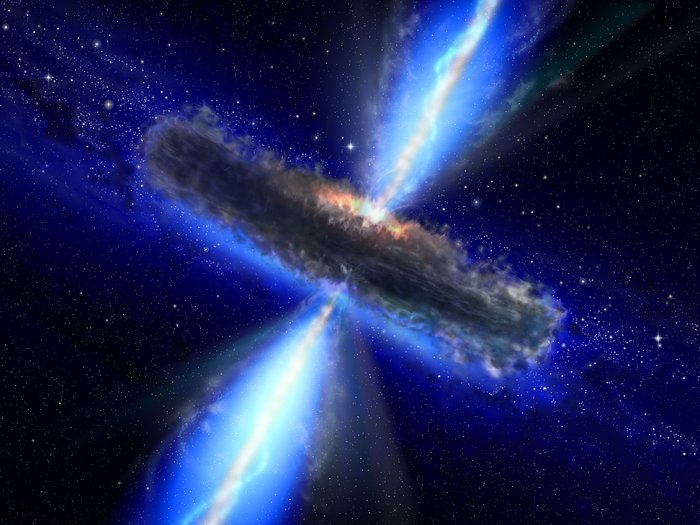A new study published in Monthly Notices of the Royal Astronomical Society, led by researchers from Newcastle University, suggests that supermassive black holes that are hidden by dust are more likely to grow and emit huge amounts of energy when they are located inside galaxies that are on course to collide with another galaxy.
Supermassive black holes exist in the centers of galaxies like our Milky Way. They are very heavy, weighing millions or billions of times more than our Sun. These black holes get bigger by attracting and “eating” gas that comes near them. But, scientists are still not sure what causes the gas to move closer to the black holes.
When galaxies get close to each other, they may be pulled towards each other by gravity and combine to form a bigger galaxy.
When gas gets close to a black hole, it produces a lot of energy. This energy is usually seen as visible light or X-rays. But in this study, the researchers only saw the growing black holes using infrared light. They used information from different telescopes, such as the Hubble Space Telescope and infrared Spitzer Space Telescope, to gather data.
To better understand the growth of galaxies and black holes during the “cosmic noon” era, researchers developed a new method to determine how likely it is for two galaxies to collide in the future. They applied this method to hundreds of thousands of galaxies that were formed 2 to 6 billion years after the Big Bang, and used data from different telescopes including the Hubble Space Telescope and the infrared Spitzer Space Telescope.
The study’s findings can be crucial in modern galactic research, as they can provide valuable insights into the growth of black holes during the ‘cosmic noon’. This time is particularly important as it is believed that most of the galaxy and black hole growth in the Universe occurred during this period. Understanding the growth of black holes during this era can help researchers better understand the evolution of galaxies, including our own Milky Way, and the supermassive black hole at its centre.
Because cosmic noon galaxies are so far away, it is challenging to measure their distances accurately, which makes it difficult to determine if any two galaxies are very close to each other with high precision.
The study introduces a novel statistical technique to address the challenge of accurately measuring the distances between galaxies and supermassive black holes during cosmic noon. This method involves analyzing images captured at different wavelengths and eliminates the need for spectroscopic distance measurements for individual galaxies.
The James Webb Space Telescope, which is set to launch later this year, is expected to provide new and improved data on the infrared light emitted by distant galaxies and supermassive black holes. This is expected to revolutionize studies in the field and reveal even more secrets about how these dusty black holes grow.
Sean Dougherty, a postgraduate student at Newcastle University and the lead author of the paper, explained that their approach is unique in that it uses statistical analysis to evaluate hundreds of thousands of distant galaxies. The method looks at the probability of two galaxies being close enough to collide, rather than measuring the distance between them directly.
Dr Chris Harrison, co-author of the study, explained that supermassive black holes are difficult to detect because the X-ray light that astronomers typically use is blocked by dust and not detected by telescopes. However, they can be found using infrared light, which is produced by the hot dust surrounding them.
Dr Chris Harrison explains that the difficulty in detecting distant galaxies with growing black holes and establishing precise distance measurements has made it challenging to study them in the past. However, with the upcoming James Webb Space Telescope, which is better equipped to detect infrared light, researchers are expecting to find many more of these hidden growing black holes. By studying these black holes, researchers can gain a better understanding of the dust that surrounds them and how many of these black holes are hidden in distant galaxies.
